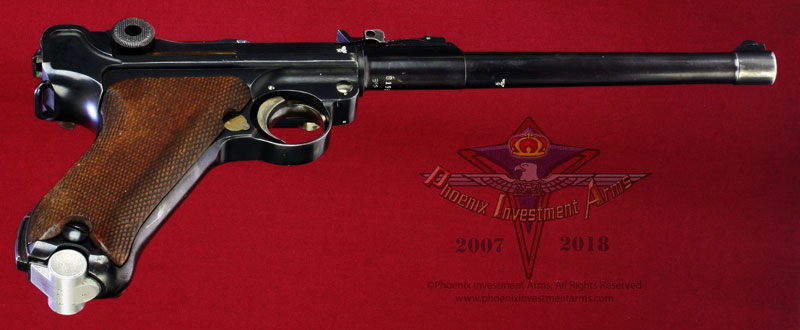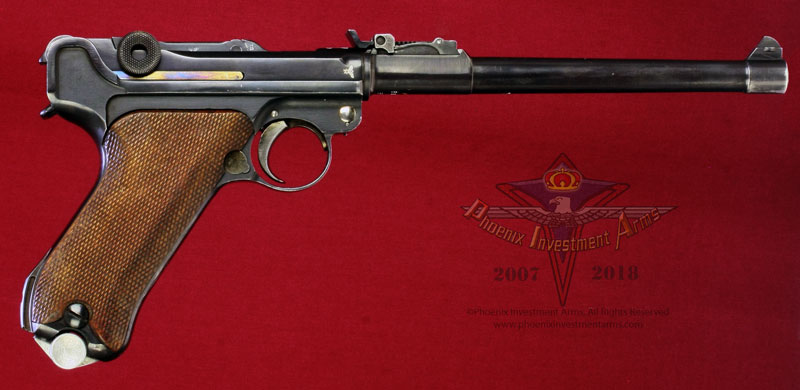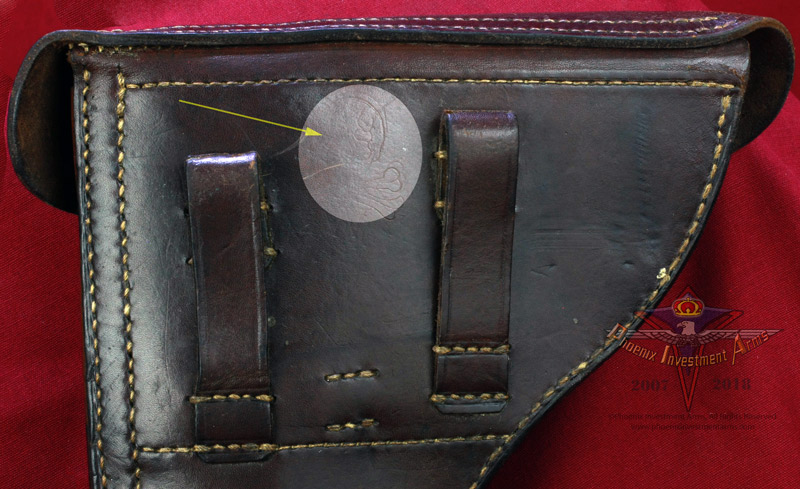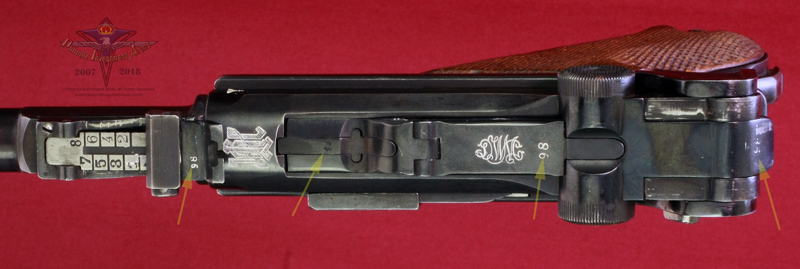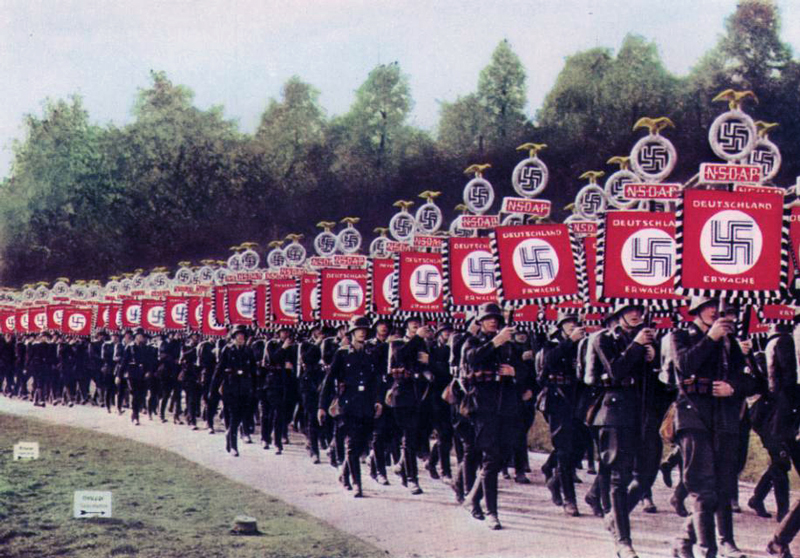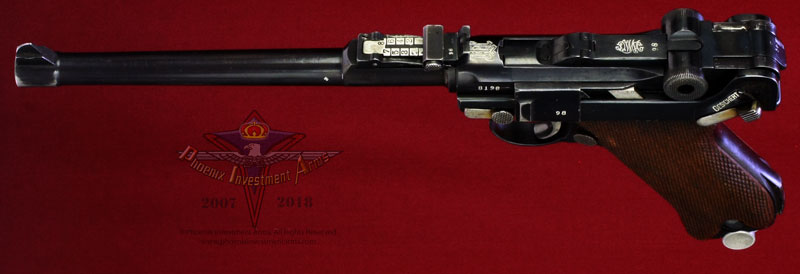 |
|
This is a 1940 Proofed WWII "Artillery Model" 200mm barrel with the 800 meter leaf sight. Over the chamber is the intertwined LAH of the
"Leibstandarte SS Adolf Hitler" indicating the owner was not just a member but was probably awarded this Parabellum since it appears to be a commercial issue. The Parabellum comes with a pre-1939 Brown Holster with belt loops and a period belt with an SS. (2036) |
|
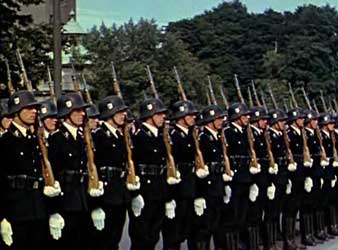 |
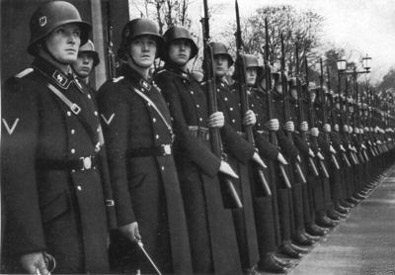 |
| Pictures of the Liebstandardte in their "parade" uniforms, during the early stages they were mocked by their fellow soldiers as just being brought out for parades. | |
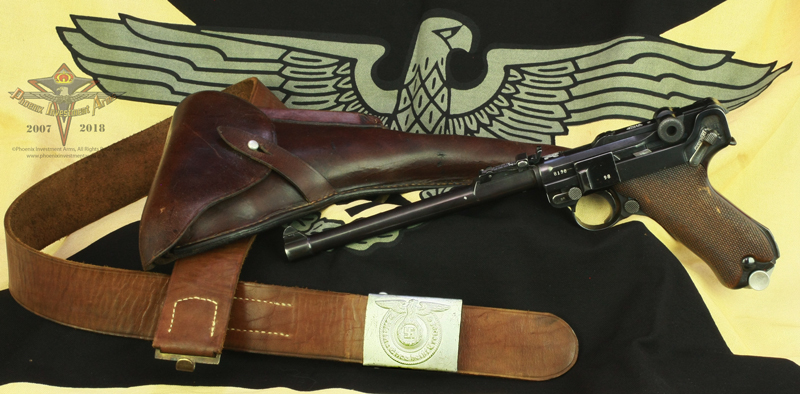
|
|
|
NOTE: Photographs taken today with the high mega-pixel camera show more than we sometimes can see with the human eye. Magnified close-ups show us tool marks and natural surface conditions that one normally doesn't see in the ordinary handling of the weapon. Photographs are copyrighted, all rights reserved, any extraction, reproduction or display of gun pictures without the express consent of the Phoenix Investment Arms is strictly prohibited. Thank you for your cooperation. Please visit Legal (tabbed) for Conditions of Sale. |
|
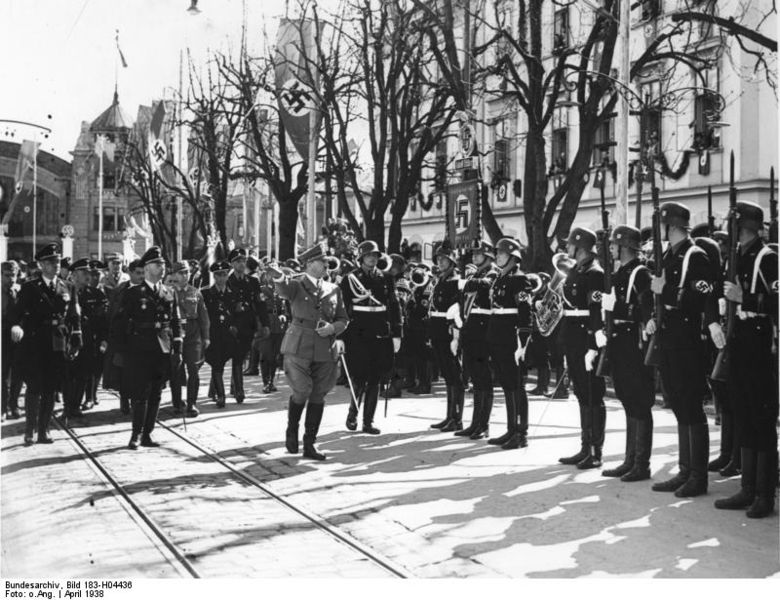
Adolf Hitler (centre) and the Leibstandarte-SS at Klagenfurt, Ger, April 1938.
|
|
|
The 1st SS Panzer Division "Leibstandarte SS Adolf Hitler", short "LSSAH", began as Adolf Hitler's personal bodyguard in 1932, and was responsible for guarding the Führer's person, offices, and residences. Initially the size of a regiment, the LSSAH eventually grew into a division-sized unit during World War II.
The LSSAH participated in combat during the invasion of Poland, amalgamated into the Waffen-SS together with the SS-Verfügungstruppe (SS-VT) and the combat units of the SS-Totenkopfverbände (SS-TV) prior to Operation Barbarossa in 1941. By mid-1942 it had been increased in size from a regiment to a Panzergrenadier division and was designated SS Panzergrenadier Division "Leibstandarte SS Adolf Hitler". It received its final form as a Panzer division in October 1943. |
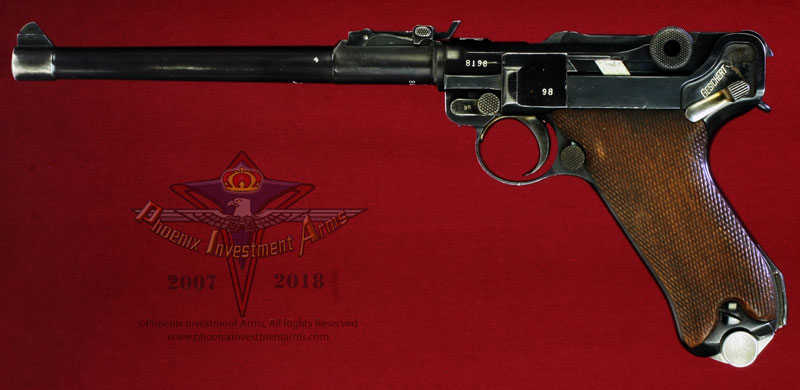
|
|
This
is a 1914 Model, with no chamber date yet with a DWM 200mm barrel and 800 meter
adjustable rear sight mounted on the barrel. The 1920's pistole is usually in a typical collection of WWI elements and in this case what appears to be an DWM frame with the "Geschert" [Safe] and a Geladen (Loaded) extractor. The Parabellum is made with the short sear enabling it to be cocked while in the "safe" position. |
|
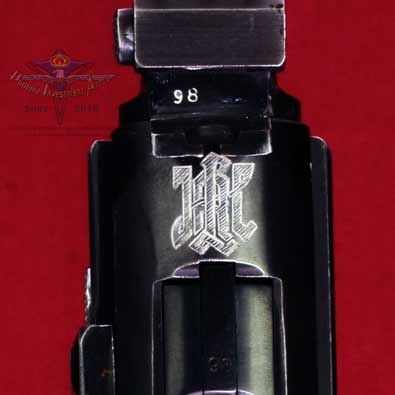 |
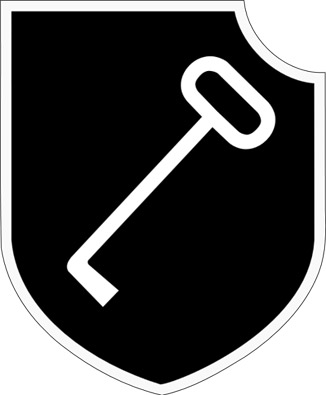 |
|
The entertwined LAH was the designed insignia of the original body guard unit whose sole purpose was to protect Der Führer (The Leader). In 1925, Hitler ordered the formation of his bodyguard unit, the Schutzkommando (protection command) which continued to expand into the designation in 1933 as Leibstandarte Adolf Hitler meaning (from old German) Guard of Corps to be evenually grow into the 1st SS Panzer Division whose symbol was the key (Above Right). |
|
|
|
|
| There is minimal holster wear and the grips show the fine diamond pattern. The springs and small parts still show the fire blue and the strawed parts are excellent. The barrel inside is shiny with distinctive lands and grooves. The magazine is clean and grips match the gun. | |
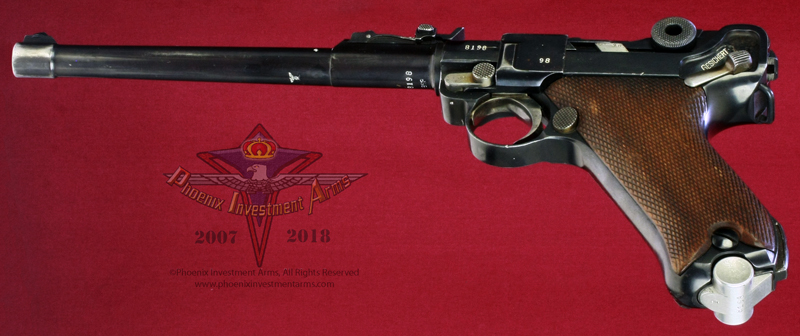 |
|
Serial number placement is in the
military ("exposed") style; displayed on the left side of the
receiver, the bottom of the side plate and the locking bolt; the forward toggle link, the front of the frame, under the
barrel, and on the side of the trigger. This example has
all matching numbers. |
|
|
|
|
| This is a 9mm weapon with all the matching parts marked in the military manner (exposed). The barrel is 200mm and it has an adjustable front site. The frame has the stock lug and the thumb safety. The thumb safety is marked "RUST" and extractor is unmarked. The barrel is numbered and proofed to the weapon. The inside of the gun is clean and well cared for. | |
|
|
|
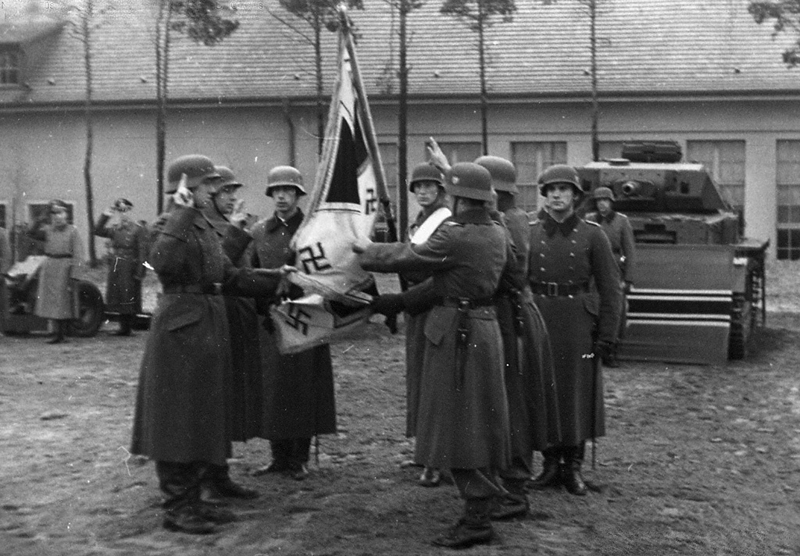 |
|
|
In the early days of the Nazi Party (NSDAP), the leadership realized that a bodyguard unit composed of reliable men was needed. Ernst Röhm formed a guard formation from the 19.Granatwerfer-Kompanie; from this formation the Sturmabteilung (SA) soon evolved. Adolf Hitler in early 1923, ordered the formation of a small separate bodyguard dedicated to his service rather than "a suspect mass", such as the SA. Originally the unit was composed of only eight men, commanded by Julius Schreck and Joseph Berchtold |
 |
|
|
The Waffen-SS was made up of three subgroups: the Leibstandarte, Hitler’s personal bodyguard; the Totenkopfverbände (Death’s-Head Battalions), and the Verfügungstruppen (Disposition Troops), which swelled to 39 divisions in World War II and which, serving as elite combat troops alongside the regular army, gained a reputation as fanatical fighters. |
|
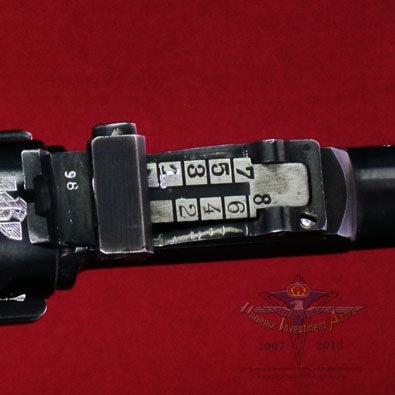
|
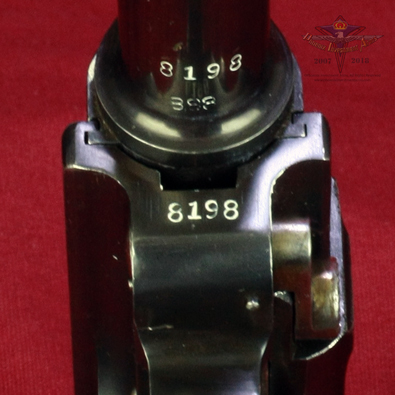
|
| Above Left: The 800 meter leaf sight is serial numbered to the gun. As the bar move forward it raises the sight to the numbered distance. Above Right: Serial number placement is in the military ("exposed") style; displayed on the left side of the receiver, the bottom of the side plate and the locking bolt; the forward toggle link, the front of the frame, under the barrel, and on the side of the trigger. The four digits tells us that this gun was assembled for the military contract and not a 1920's commercial version. Below Right: The magazine is silver wrapped as was those used in the 1930's; another dichotomy of this gun. | |
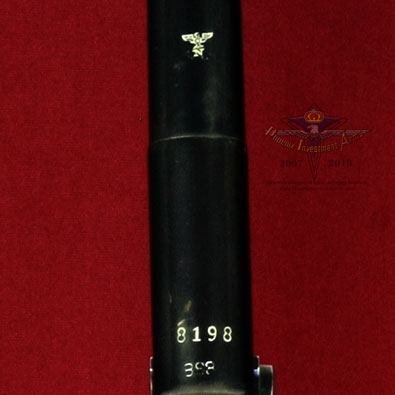 |
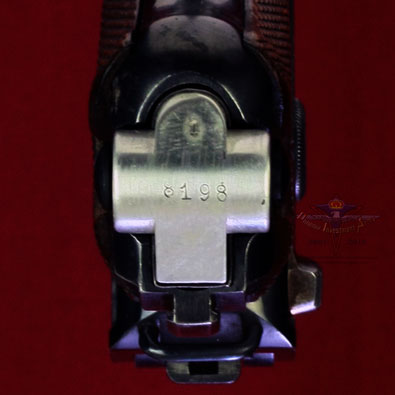 |
| Under the barrel is the four digit serial number and the gauge markings, yet above these early signs of production is the Eagle N commercial proof that was not introduced until January 1940. | |
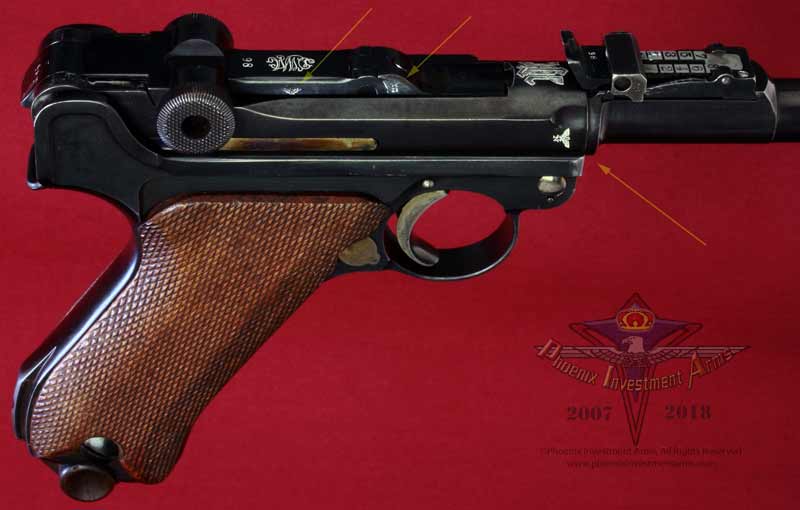 |
|
| On the right side of the receiver, the breech block and 1st toggle link is the Eagle N begun only in January 1940. This was long after the cessation of the Parabellum by DWM (1930) and well into the period of Mauser production. This Luger was surely a special order for someone to be assembled with all DWM parts clearly not produced after 1919 but probably available in the stocks of Mauser who filled the Persian and Siamese contracts with DWM parts guns, (however proofed by Mauser). This Parabellum went to the German commercial proof without a manufacturerors proof. | |
 |
|
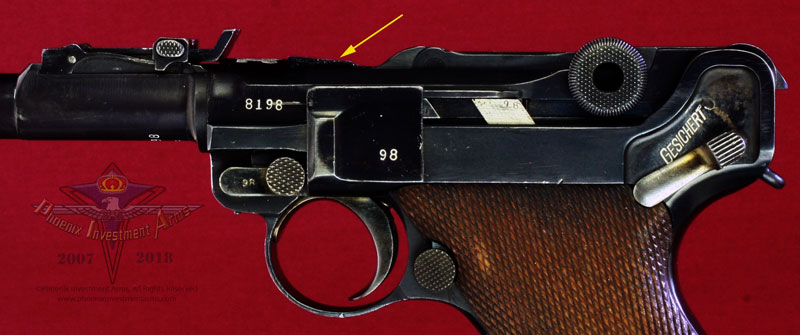 |
|
The extractor is marked 'GELADEN' [Loaded] which when extended tell the shooter that a round is in the chamber and is both visible and tactilely notice. |
|
 |
|
The early protective unit was designated the Stabswache (staff guard). The Stabswache were issued unique badges, but at this point was still under SA control. Schreck resurrected the use of the Totenkopf ("death's head") as the unit's insignia, a symbol various elite forces had used in the past, including specialized assault troops of Imperial Germany in World War I who used Hutier infiltration tactics. In May 1923, the unit was renamed Stoßtrupp (Shock Troop)–Hitler.The unit numbered no more than 20 members at that time. Pictured above (center) is Oberst-Gruppenführer Josef "Sepp" Dietrich. |
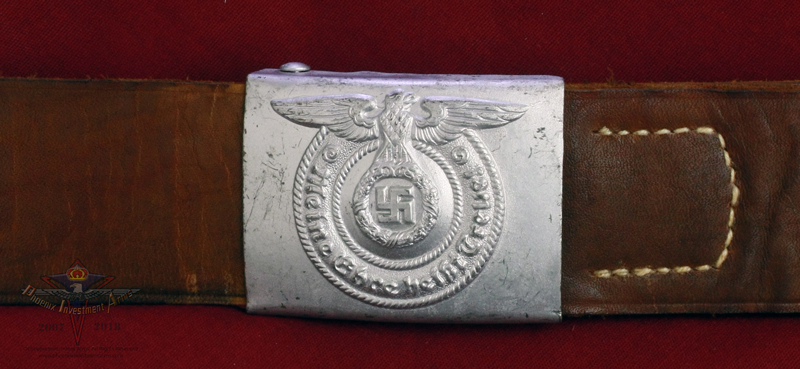
|
|
|
Above: The enlisted SS belt buckle - The SS
motto was "Meine Ehre heißt Treue" ("My honor
is Loyalty.") The SS rank system was unique in that it did
not copy the terms and ranks used by the Wehrmacht's
branches (army, air force, navy), but instead used the ranks
established by the post-WWI Freikorps and taken over by the
SA. This was mainly done to establish the SS as being
independent from the Wehrmacht, although SS ranks do
generally have equivalents in the other services.
|
|
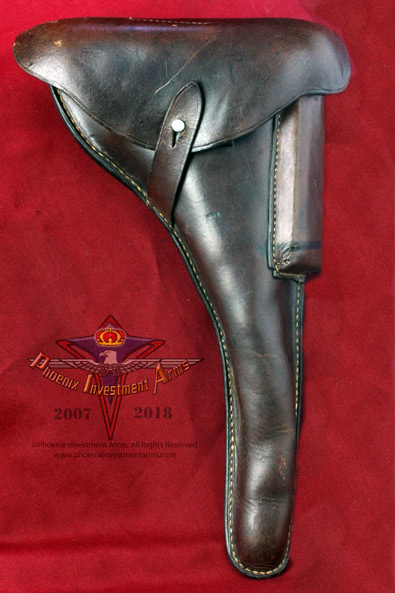
|
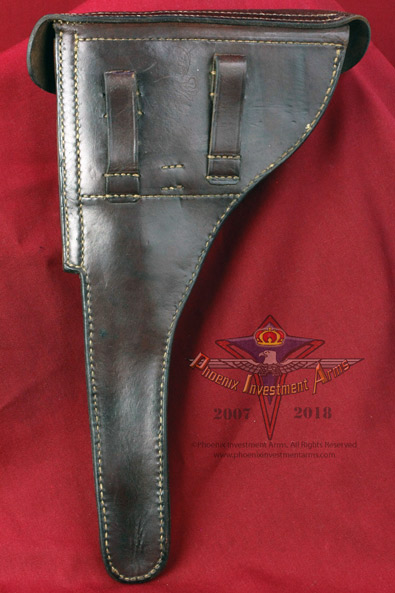
|
|
This is quality leather with white stitching and soft pliable leather. The pull strap is attached and fully functional. This was in all likelihood a presentation gun give for some feat or act of bravery. |
|
|
|
|
This holster shows no evidence it was ever created with the stock block or shoulder carrying straps in the WWI manner. Between the belt loops is an old impression of a skull with crossed bones in the manner of the post WWI Werewolf insignia.
|
|
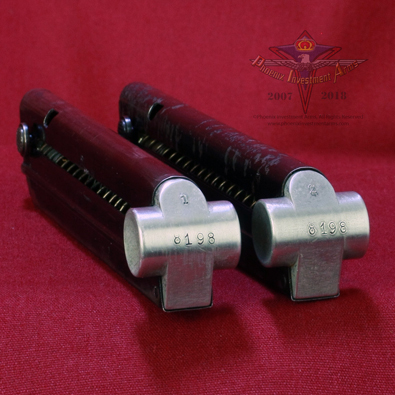 |
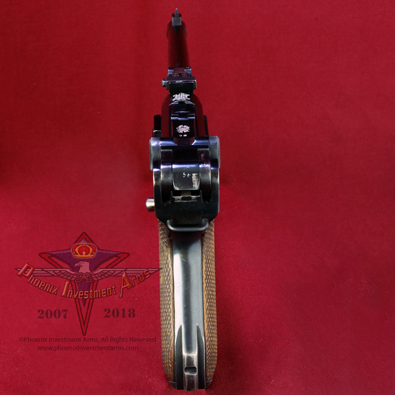 |
| The two magazines, wrapped and crimped metal with aluminum bottom with one pin; typically issued on the 1937-1939 Mauser models. | |
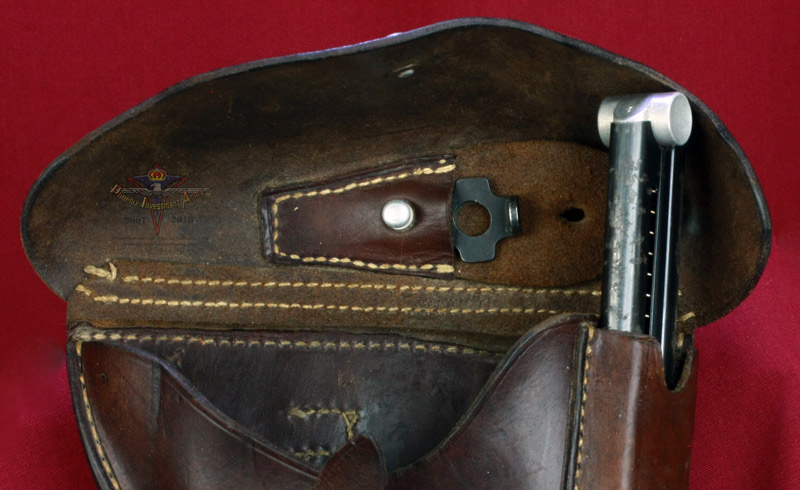 |
|
|
The inside of the holster shows good clean stitching and the magazine loader pouch all in excellent working order. |
|
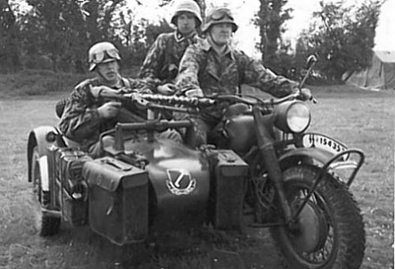 The key insignia on the front of the side car identifies this unit as the Leibstandarte SS Adolph Hitler |
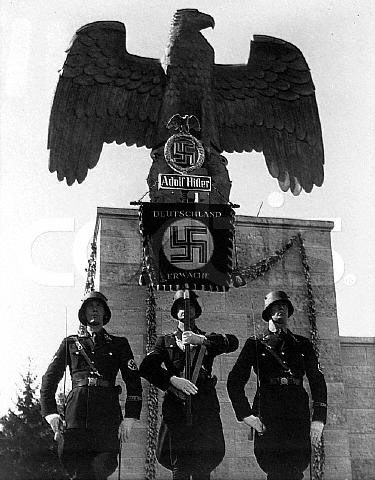 |
|
The LSSAH participated in combat during the invasion of Poland, amalgamated into the Waffen-SS together with the SS-Verfügungstruppe (SS-VT) and the combat units of the SS-Totenkopfverbände (SS-TV) prior to Operation Barbarossa in 1941. By mid-1942 it had been increased in size from a regiment to a Panzergrenadier division and was designated SS Panzergrenadier Division "Leibstandarte SS Adolf Hitler". It received its final form as a Panzer division in October 1943. |
|
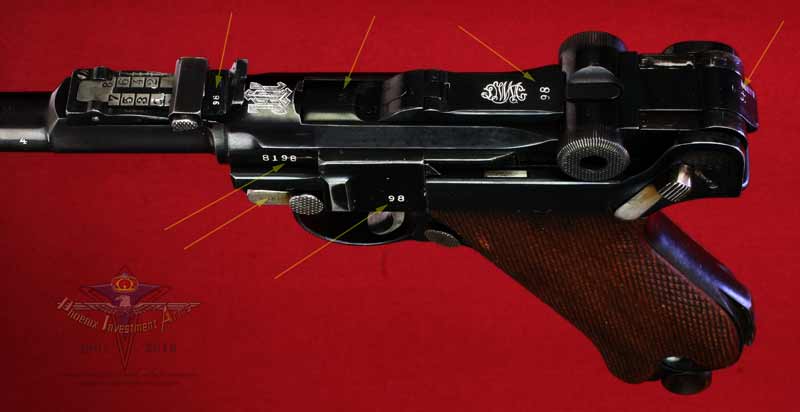
|
|
| Serial number placement is in the military ("exposed") style. The serial number appears on the front of the frame, on the side of the locking bolt, on the trigger, on the bottom of the barrel, the side plate, the left side of the receiver, the safety bar, the sear bar, the rear connecting pin, and on the extractor. | |
|
|
|
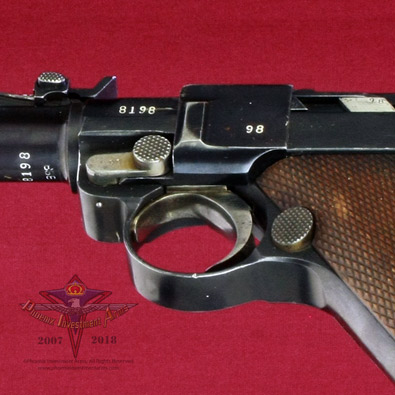
|
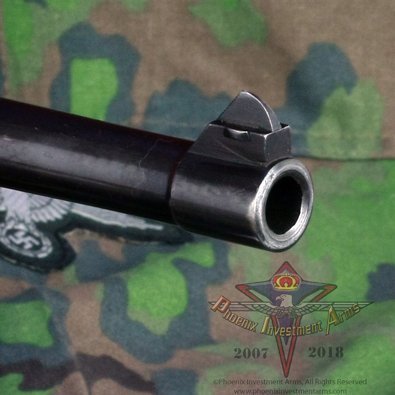
|
|
This 1917 Luger is characterized by the 9mm 8" (200mm) barrel and was built with a hold open and utilized the short sear. The rear sight is the 800 meter leaf and front dovetailed sight; the frame has the stock lug and hold open device. |
|
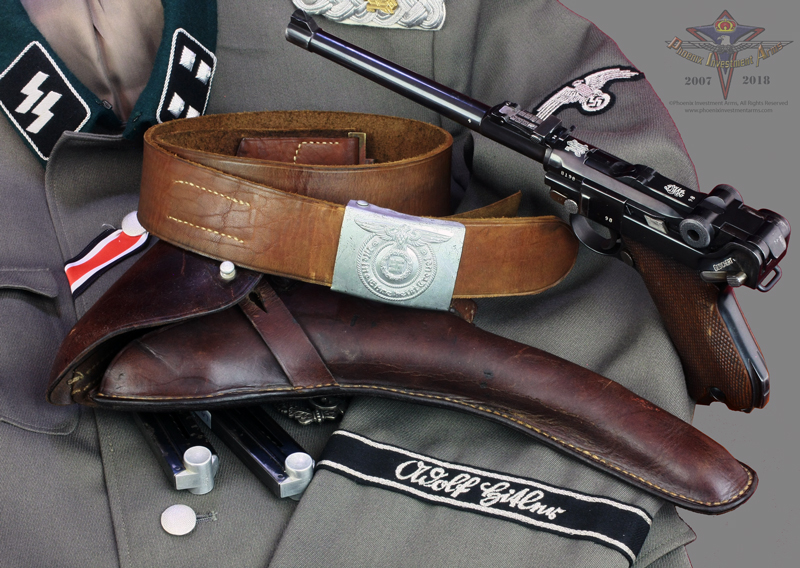 |
|
| The LSSAH or Leibstandarte Adolf Hitler was the only unit to wear the Adolf Hitler cuff badge on their dress uniforms. This was considered a distinct honor with other SS Units to have a cuff badge to include, Großdeutschland, Wiking, SS Polizei Division, and Germania among others. | |
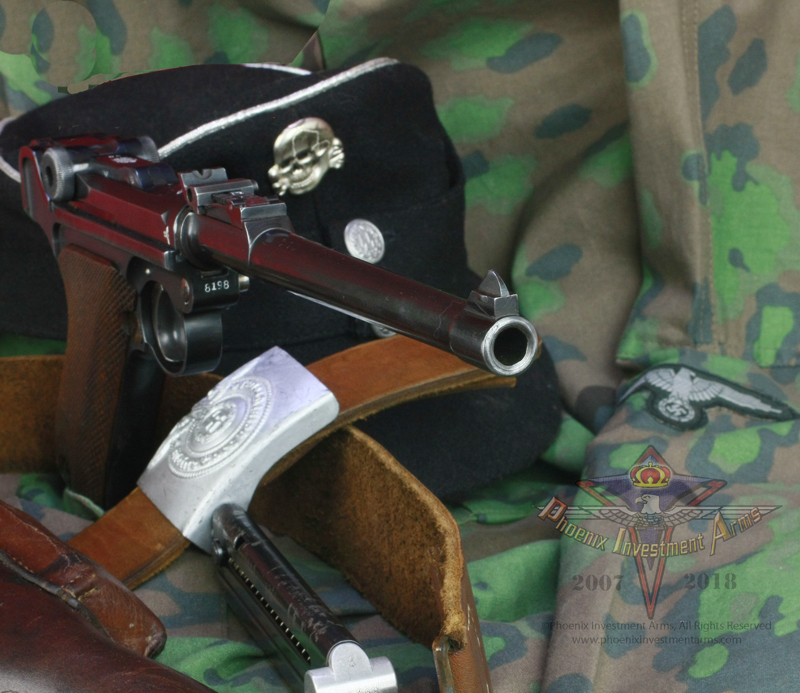 |
|
|
|
|---|
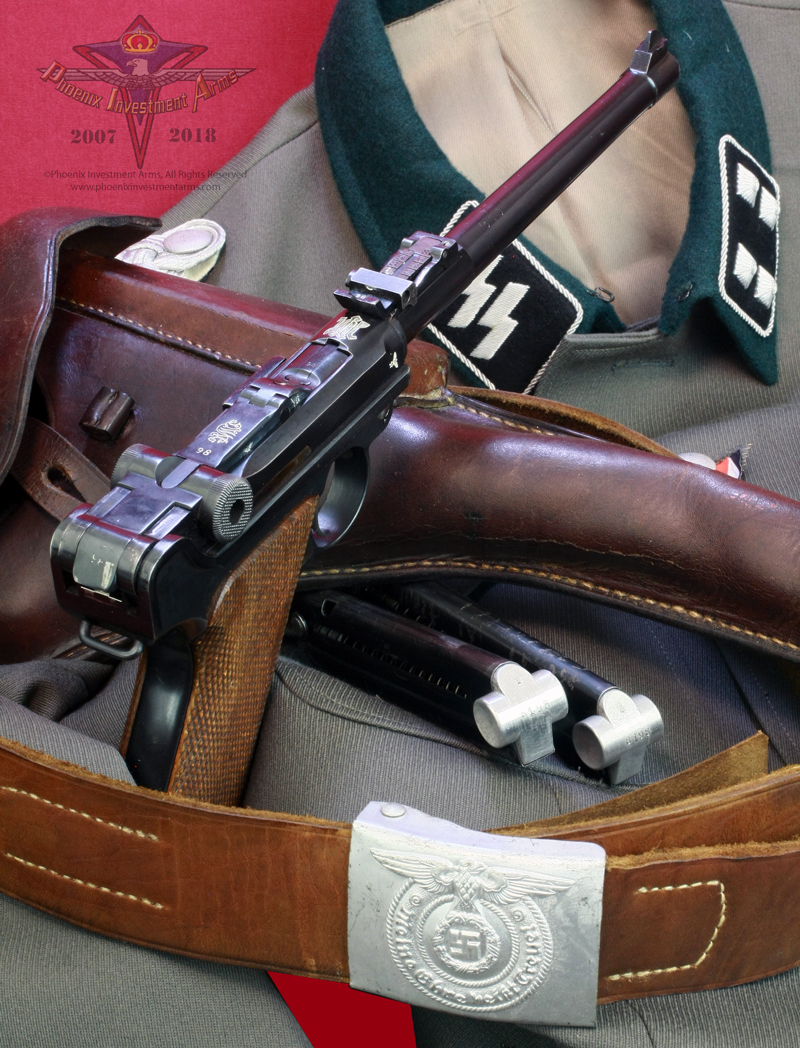
|
|
|
In 1939 the order went out that all the leather accruetements would now be black except for some of the police units. This leather escaped the die perhaps because it was personally owned by a member of the LSSAH or he wore it with his field uniform. Proofed after January 1940, the introduction of the Eagle N proof and long after the contract production of the Lange Pistole as the 'artillery' model was known with a custom made holster this had to be a presentation gun to a very early soldier of the Nazi party. |
|
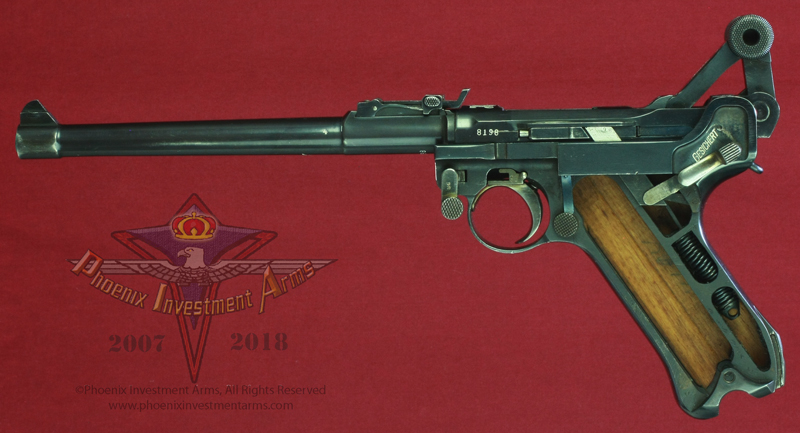
|
|
|
This rig includes (1) Undated but 1940 proofed 200mm barrel all matching Parabellum, one brown soft textured holster, two matching magazines brown leather belt and enlisted SS belt buckle. |
|
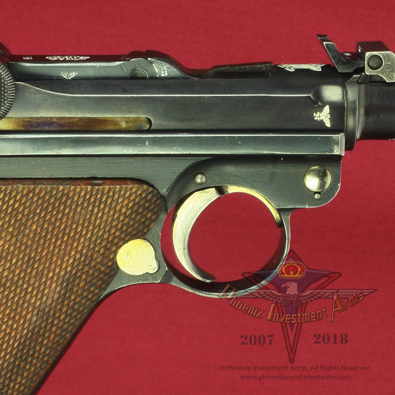
|
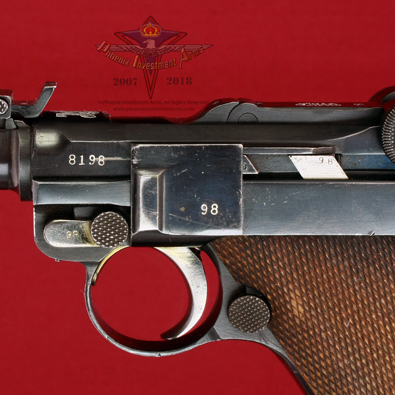
|
|
Above Left: The proof marks on the right of the receiver indicating Eagle N (not to appear before 1940) and no drooped wing eagle "Reich Adler" Waffenamt proof of military acceptance on the receiver and the right side of the barrel. Above Right: On the left of the receiver is the four digit of the serial number on the chamber, the last two digits on the side plate and locking lever. On top of the Parabellum you can see the extractor with two digits, the breach block has the last two digits on the side and the first toggle link on top (visible) while the 2nd toggle link is on the back. |
|
 |
|
| The top of the Luger shows us all the matching numbers including the front signt, the ejector, the 1st toggle link, the rear of the back toggle link and the top of the thumb safety. All matching. | |

|
|
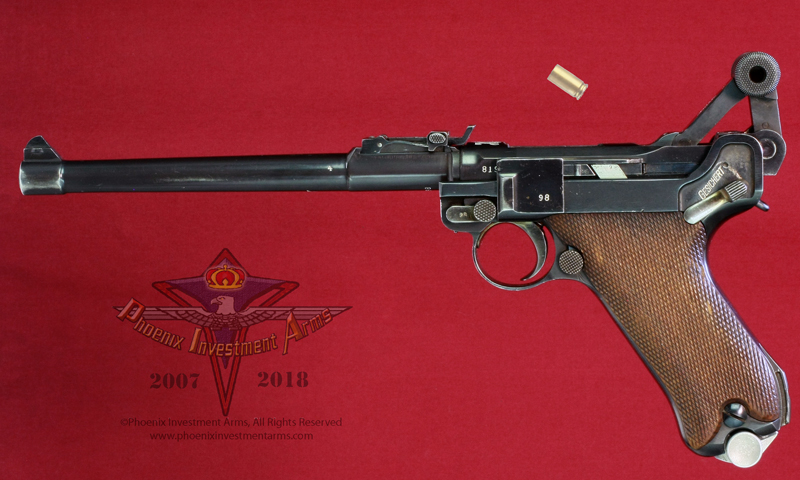 |
|
|
The most distinctive feature of these pistols is undoubtedly the toggle-lock mechanism, which holds the breech closed by locking in a manner not unlike the human knee, which can sustain a heavy weight when straight, but once bent is quite easy to continue to bend. The toggle joint in its straight position resists the rearward force of the detonating cartridge, then "buckles" after enough time has passed. When a round is fired the entire breech, barrel and toggle move straight rearward (on rails) until the toggle begins to ride up on a pair of cams that "breaks" the toggle (makes it bend at the joint). Once the toggle joint is no longer straight, it bends freely, allowing the bolt to come rearward, and the striker to be cocked. The spent cartridge is extracted by a combination extractor/loaded chamber indicator on the top of the toggle, is ejected as the toggle nears the end of its rearward free travel, returning, and a new round is stripped from the magazine and chambered as the toggle is driven back to the straight position by a spring. |
|
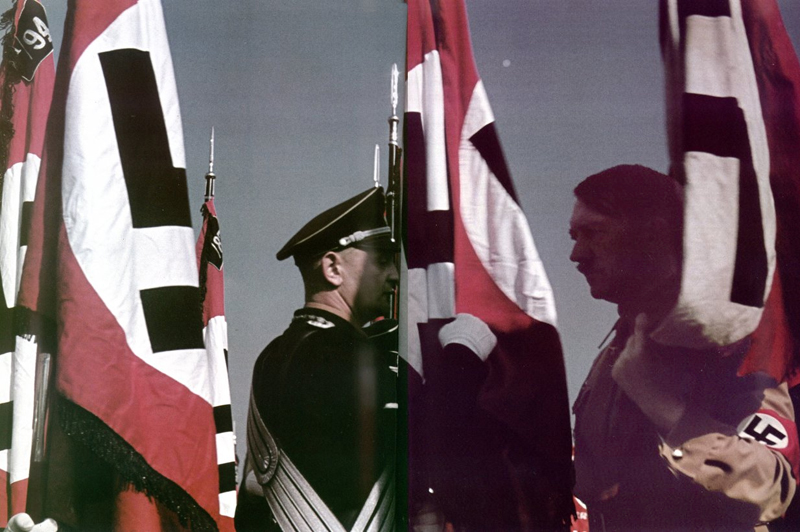 |
|
|
Here is Der Führer swearing in a new flag with the Blutfahne (the blood flag) alleged to have been soaked in the blood of the flag bearer that was carried during the failed Beer Hall Putsch in Munich, Germany on 9 November 1923. It subsequently became one of the most revered objects of the NSDAP (Nazi Party). It was used in ceremonies in which new flags for party organizations were consecrated by the Blood Flag when touched by it. |

|
|
This is a excellent example of the hard to
find War I, undated DWM Imperial Artillery Parabellum and proofed after 1940 with the LAH [Leibstandarte Adolf Hitler] engraved over the chamber. Theis rig had to be made "by order" with the 1914 style parts yet proofed with 1940 proofs. It comes with two matching magazines, a brown 'artillery' holster, and a brown belt with an enlisted SS belt buckle. |
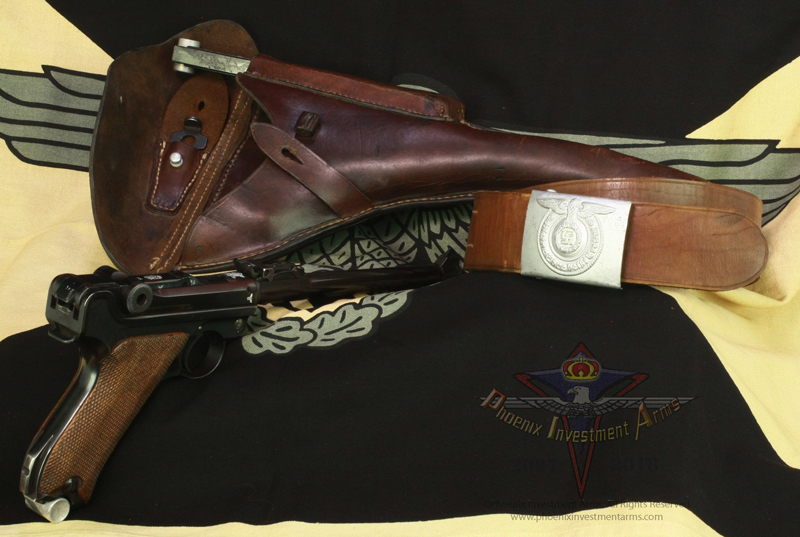
|
